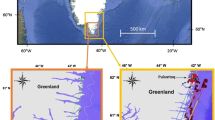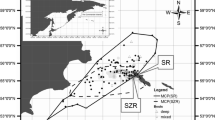Summary
Lactation strategies in the two largest families of seals have been characterized as a phylogenetic dichotomy, with sea lions and fur seals (Otariidae) exhibiting foraging cycles and true seals (Phocidae) a strategy of fasting. We show that a lactating phocid, the harbor seal, Phoca vitulina, has a foraging cycle similar to that of otariids. Time-depth recorders attached to lactating harbor seal mothers revealed that 9 of 11 females began bouts of diving, averaging 12–40 m, by mid-lactation (12 days). During the remainder of lactation, females made an average of seven diving trips, lasting about 7 h. They returned to the rookery during the interval between successive bouts to nurse their pups. Diving was more frequent during daylight than at night and diving bouts increased in duration as lactation progressed. The diving behavior of females that had weaned their pups and previously collected data from stomach lavage, suggest that the bouts of diving represent successful foraging. We propose that the lactation strategy of the harbor seal is intermediate to that of the otariids and other phocids studied. The harbor seal has a foraging cycle like the otariids, but typically resembles other phocids in length of lactation, rate of mass gain in pups, and in milk fat content. As harbor seals are among the smallest phocids, and only slightly larger than most otariids, it seems likely that maternal size constrains the amount of stored energy harbor seal females can bring to the rookery, forcing them to start feeding during the lactation period.
Similar content being viewed by others
References
Bartholomew GA (1970) A model for the evolution of pinniped polygyny. Evolution 24:546–559
Bartholomew GA, Hoel PG (1953) Reproductive behavior of the Alaska fur seal Callorhinus ursinus. J Mammal 34:417–436.
Bekoff M, Diamond J, Mitton JB (1981) Life-history patterns and sociality in canids: body size reproduction and behavior. Oecologia 50:386–390
Bishop RH (1967) Reproduction, age determination and behaviour of the harbor seal, Phoca vitulina L. in the Gulf of Alaska. MSc Dissertation, University of Alaska
Blueweiss L, Fox H, Kudzma V, Nakashima D, Peters R, Sams S (1978) Relationships between body size and some life history patterns. Oecologia 37:257–272
Bonner WN (1984) Lactation strategies in Pinnipeds: problems for a marine mammalian group. Symp Zool Soc London 51:253–272
Bowen WD, Boness DJ, Oftedal OT (1987) Mass transfer from mother to pup and subsequent mass loss by the weaned pup in the hooded seal, Cystophora cristata. Can J Zool 65:1–8
Bowen WD, Oftedal OT, Boness DJ (1989) Variation in the efficiency of mass transfer in harbour seals, Phoca vitulina, over the course of lactation. Abstr 8th Bienn Conf Biol Mar Mamm, Pacific Grove, Society for Marine Mammalogy, p. 8
Bowen WD, Oftedal OT, Boness DJ (1992) Mass and energy transfer during lactation in a small phocid, the harbor seal (Phoca vitulina). Physiol Zool 65:844–866
Boyd IL, Arnbom T (1991) Diving behaviour in relation to water temperature in the southern elephant seal: foraging implications. Polar Biol 11:259–266
Boyd IL, Croxall JP (1992) Diving behavior of lactating fur seals. Can J Zool 70:919–928
Boyd IL, Lunn NJ, Barton T (1991) Time budgets and foraging characteristics of lactating Antarctic fur seals. J Anim Ecol 60:577–592
Carrick R, Csordas SE, Ingham SE (1962) Studies on the southern elephant seal, Mirounga leonina (L.) IV. Breeding and development. CSIRO Wildl Res 7:161–197
Clutton-Brock TH (1991) The evolution of parental care. Princeton University Press, Princeton
Clutton-Brock TH, Harvey PH (1983) The functional significance of variation in body size among mammals. In: Eisenberg JF, Kleiman DG (eds) Advances in the study of mammalian behavior. American Society of Mammalogists, Pittsburgh, pp 632–663
Costa DP (1987) Isotopic methods for quantifying material and energy intake of free-ranging marine mammals. In: Huntley AC, Costa DP, Worthy GAJ, Castellini MA (eds) Marine mammal energetics. Society for Marine Mammalogy, Lawrence, pp 43–66
Costa DP (1991) Reproductive and foraging energetics of pinnipeds: implications for life-history patterns. In: Renouf D (ed) The behaviour of pinnipeds. Chapman and Hall, London, pp 300–344
Costa DP, Le Boeuf BJ, Huntley AC, Ortiz CL (1986) The energetics of lactation in the northern elephant seal, Mirounga angustirostris. J Zool London 209:21–33
Eliason JJ (1986) Mother-pup behavior in the harbor seal, Phoca vitulina richardsi. MA thesis, Department of Biological Sciences, Humboldt State University, Trinidad, CA
Fedak MA, Anderson SS (1982) The energetics of lactation: accurate measurements from a large wild mammal, the grey seal (Halichoerus grypus). J Zool London 198:473–479
Gentry RL, Kooyman GL (1986) Fur seals: maternal strategies on land and at sea. Princeton University Press, Princeton
Gentry RL, Costa DP, Croxall JP, David JHM, Davis RW, Kooyman GL, Majluf P, McCann TS, Trillmich F (1986) Synthesis and conclusions. In: Gentry RL, Kooyman GL (eds) Fur seals: maternal strategies on land and at sea. Princeton University Press, Princeton, pp 220–264
Goldsworthy SD (1992) Maternal care in three species of southern fur seal (Arctocephalus spp.). PhD Dissertation, Monash University
Heath CB, Ono KA, Boness DJ, Francis JM (1991) The influence of El Niño on female attendance patterns in the California sea lion. In: Trillmich F, Ono KA (eds) Pinnipeds and El Niño: responses to environmental stress. Springer, Heidelberg, pp 138–145
Hindell MA, Slip DJ, Burton HR, Bryden MM (1992) Physiological implications of continuous, prolonged, and deep dives of the southern elephant seal (Mirounga leonina). Can J Zool 70:370–379
Kovacs KM, Lavigne DM (1986) Maternal investment and neonatal growth in phocid seals. J Anim Ecol 55:1035–1051
Le Boeuf BJ, Naito Y, Huntley AC, Asaga T (1989) Prolonged, continuous, deep diving by northern elephant seals. Can J Zool 67:2514–2519
Le Boeuf BJ, Naito Y, Asaga T, Crocker D, Costa DP (1992) Swim speed in a female northern elephant seal: metabolic and foraging implications. Can J Zool 70:786–795
Loudon ASI, Kay RNB (1984) Lactational constraints on a seasonally breeding mammal: the red deer. Symp Zool Soc London 51:233–252
Loughlin TR, Bengston JL, Merrick RL (1987) Characteristics of feeding trips of female northern fur seals. Can J Zool 65:2079–2084
McCann TS (1982) Aggressive and maternal activities of female southern elephant seals (Mirounga leonina). Anim Behav 30:268–276
McCann TS, Fedak MA, Harwood J (1989) Parental investment in southern elephant seals, Mirounga leonina. Behav Ecol Sociobiol 25:81–87
Miller SA (1988) Movement and activity patterns of harbor seals at the Point Reyes peninsula, California. Masters Dissertation, University of California, Berkeley.
Oftedal OT (1993) The adaptation of milk secretion to the constraints of fasting in bears, seals and baleen whales. J Dairy Sci 76:3234–3246
Oftedal OT, Iverson SJ (1987) Hydrogen isotope methodology for measurement of milk intake and energetics of growth in suckling young. In: Huntley AC, Costa DP, Worthy GAJ, Castellini MA (eds) Marine mammal energetics. Society for Marine Mammalogy, Lawrence, pp 67–96
Oftedal OT, Boness DJ, Tedman RA (1987) The behavior, physiology, and anatomy of lactation in the Pinnipedia. Curr Mammal 1:175–245
Ono KA, Boness DJ, Oftedal OT (1987) The effect of a natural environmental disturbance on maternal investment and pup behavior in the California sea lion. Behav Ecol Sociobiol 21:109–118
Peterson RS (1968) Social behavior of pinnipeds with particular reference to the northern fur seal. In Harrison RJ, Hubbard RC, Peterson RS, Rice CE, Schusterman RJ (eds) The behavior and physiology of pinnipeds. Appleton-Century-Crofts, New York, pp 3–53
Reiter J, Stinson NL, Le Boeuf BJ (1978) Northern elephant seal development: the transition from weaning to nutritional independence. Behav Ecol Socibiol 3:337–367
Renouf D, Lawson J, Gaborko L (1983) Attachment between harbour seal (Phoca vitulina) mothers and pups. J Zool London 199:179–187
Robbins CT, Robbins BL (1979) Fetal and neonatal growth patterns and maternal reproductive effort in ungulates and subungulates. Am Nat 114:101–116
Smith TG, Hammill MO, Taugbol G (1991) A review of the developmental, behavioural and physiological adaptations of the ringed seal, Phoca hispida, to life in the Arctic winter. Arctic 44:124–131
Stirling I (1971) Studies on the behavior of the South Australian fur seal, Arctocephalus forsteri (Lesson). II. Adult females and pups. Aust J Zool 19:267–273
Stirling I (1975) Factors affecting the evolution of social behaviour in the Pinnipedia. Rapp P-V Reun Cons Int Explor Mer 169:205–212
Testa JW, Hill SEB, Siniff DB (1989) Diving behavior and maternal investment in Weddell seals (Leptonychotes weddelli). Mar Mamm Sci 5:399–406
Thompson PM, Fedak MA, McConnell BJ, Nicholas KS (1989) Seasonal and sex-related variation in the activity patterns of common seals (Phoca vitulina). J Appl Ecol 26:521–535
Thompson PM, Miller D, Cooper R, Hammond PS (1993) Changes in the distribution and activity of female harbour seals during the breeding season: implications for their lactation strategy and mating patterns. J Anim Ecol in press
Trillmich F (1986) Attendance behavior of Galapagos sea lions. In: Gentry RL, Kooyman GL (eds) Fur seals: maternal strategies on land and at sea. Princeton University Press, Princeton, pp 196–208
Trivers RL (1972) Parental investment and sexual selection. In: Campbell B (ed) Sexual selection and the descent of man, 1871–1971. Aldine, Chicago, pp 136–179
Venables UM, Venables LSV (1955) Observations on a breeding colony of the seal Phoca vitulina in Shetland. Proc Zool Soc London 125:521–532
White RG, Luick JR (1984) Plasticity and constraints in the lactational strategy of reindeer and caribou. Symp Zool Soc London 51:215–232
Wilson S (1974) Mother-young interactions in the common seal, Phoca vitulina vitulina. Behaviour 48:23–36
Author information
Authors and Affiliations
Additional information
Correspondence to: D.J. Boness
Rights and permissions
About this article
Cite this article
Bonessl, D.J., Bowen, W.D. & Oftedall, O.T. Evidence of a maternal foraging cycle resembling that of otariid seals in a small phocid, the harbor seal. Behav Ecol Sociobiol 34, 95–104 (1994). https://doi.org/10.1007/BF00164180
Received:
Accepted:
Issue Date:
DOI: https://doi.org/10.1007/BF00164180




